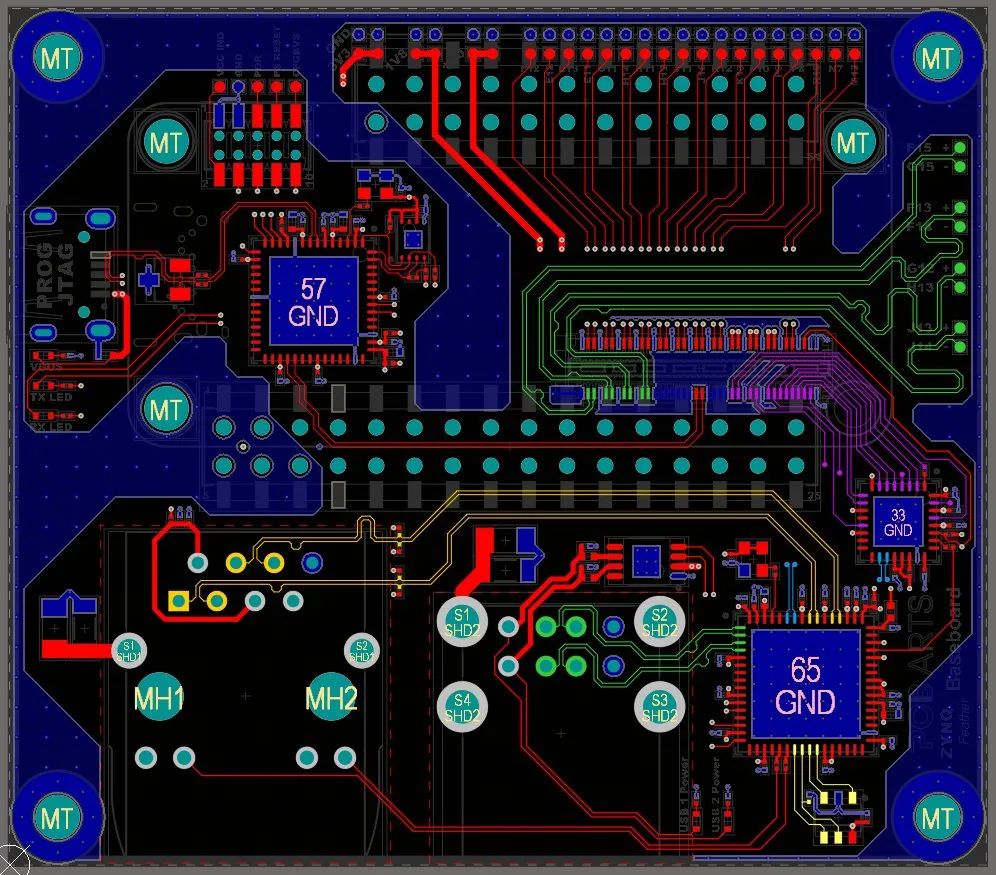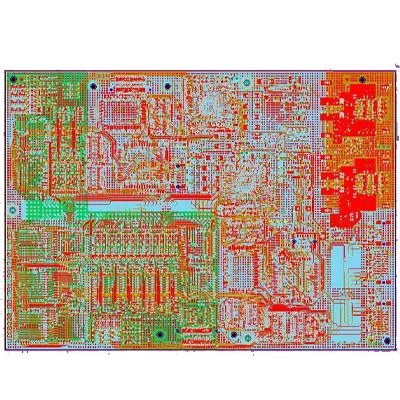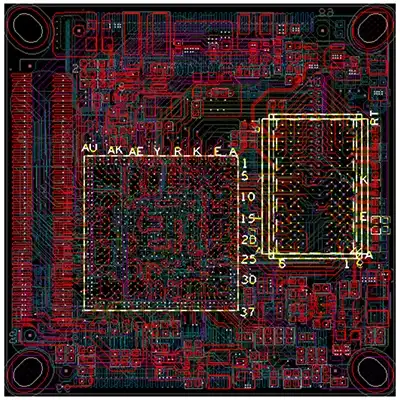Tg value of PCB board
For a long time in the industry, the Tg value has been the most common index used to classify FR-4 substrates. It is generally believed that the higher the Tg value, the higher the reliability of the material.
For example, in the picture below, the description of FR-4 plates intercepted by Lao Wu on South Asia:
Tg135℃, plate use: motherboard, consumer electronics, etc.
Tg180℃, plate use: CPU motherboard, DDR3 memory substrate, IC packaging substrate, etc.
the

Substrates are as important to printed circuit boards as printed circuit boards are to electronic devices. According to the nature of the substrate of the PCB, it can be divided into two large systems: the organic substrate and the inorganic substrate.
The organic substrate consists of multiple layers of paper impregnated with phenolic resin or layers of non-woven fabric or glass cloth impregnated with epoxy resin, polyimide, cyanate ester, BT resin, etc. The use of these substrates depends on the physical properties required for the PCB application, such as operating temperature, frequency or mechanical strength.
Inorganic substrates mainly include ceramic and metal materials such as aluminum, soft iron, and copper. The use of these substrates usually depends on the cooling needs.
Our commonly used rigid printed board substrates are organic substrates, such as FR-4 epoxy glass fiber cloth substrates, which use epoxy resin as an adhesive and electronic grade glass fiber cloth as a reinforcing material.
We see that FR-4 uses epoxy resin as a binder, and the resin material has an important characteristic parameter: the glass transition temperature Tg (glass transition temperature), which refers to the transition of the material from a relatively rigid or "glass" state to The temperature transition point of the volatile or softening state.
The temperature at which a glassy substance reciprocally changes between the glassy state and the hyperelastic state. What do you mean? That is to say, if the temperature of the adhesive epoxy resin of the FR-4 substrate is lower than Tg, the material is in a rigid "glass state". When the temperature is higher than Tg, the material exhibits a rubber-like soft and flexible property. right! It~ became [soft]~ o(* ̄︶ ̄*)o
glassy state
The state of the resin material below the temperature Tg is a hard solid, that is, a glass state. There is a certain deformation under the action of external force, but the deformation is reversible, that is, after the external force disappears, the deformation also disappears, which is the use state of most resins.
high elastic state
When the heated temperature of the resin exceeds Tg, the molecular chains in the amorphous state start to move, and the resin enters a highly elastic state. A resin in this state resembles an elastomer in its rubbery state, but still possesses reversible deformation properties.
Note that after the temperature exceeds the Tg value, the material gradually becomes softer, gradually, and as long as the resin does not decompose, when the temperature cools below the Tg value, it can still return to the rigid state with the same properties as before.
Nitrogen has a Td value, which is called thermal decomposition temperature. When the resin material is heated to a certain high temperature point, the resin system begins to decompose. The chemical bonds in the resin begin to break and with the volatile components overflowing, the resin in the PCB substrate becomes less. The Td point refers to the temperature point at which this process begins to occur. Td is usually defined as the decomposition temperature corresponding to the loss of 5% of the original mass. But this 5% is very high for a multi-layer PCB.
We know that the factors that affect the characteristic impedance of the transmission line on the PCB include the line width, the distance between the trace and the reference plane, the dielectric constant of the board, and so on. The amount of resin in the substrate material has a great influence on the dielectric properties, and the volatilization of the resin also affects the distance between the control line and the reference plane.
For the lead-free soldering process, this Td value needs to be considered. For example, the temperature range of the traditional tin-lead soldering process is 210~245°C, while the temperature range of the lead-free soldering process is 240~270°C.
The two screenshots below are the comparison of the two board parameter tables that Lao Wu downloaded from Kingboard’s official website. The left one is FR-4 conventional series boards, and the right one is FR-4 lead-free boards.
The Tg value of conventional FR4 sheet KB-6160 is 135°C, and the Td value of 5% mass loss is 305°C
FR4 lead-free sheet KB-6168LE has a Tg value of 185°C and a 5% mass loss Td value of 359°C
We have seen that the Td value of conventional FR4 boards is above 300°C, while the lead soldering process temperature ranges from 240 to 270°C. The Td value is completely satisfactory. Why do we need a lead-free version?
As mentioned above by old wu, the 5% resin mass volatilization rate is too large for a multi-layer PCB that needs to control the impedance. For the tin-lead soldering process, the material at a temperature of 210~245°C basically does not appear obvious Thermal decomposition, and the temperature range of 240~270℃ for lead-free soldering, for ordinary Tg FR-4 substrates, has begun to lose 1.5~3% of the resin mass. Although less than the 5% required by the IPC standard, this loss of resin quality cannot be ignored. At the same time, this level of decomposition may affect the long-term reliability of the base material or cause defects such as delamination or voids during soldering, especially when multiple soldering processes are required or where rework heating is present.
Therefore, if a lead-free soldering process is used, in addition to considering the Tg value, the Td value must also be considered.
The performance of the substrate material is very different when it is above the Tg value and below the Tg value. However, the Tg value is generally described as a very accurate temperature value, such as Tg135. It does not mean that the substrate will become soft when the temperature exceeds 135°C. However, when the temperature is close to the Tg value, the material properties of the material will begin to change, which is a gradual change process.
The Tg value of the resin system affects the performance of the material mainly in two aspects:
Effect of Thermal Expansion
Resin system curing time
The plate is heated and expanded, and the brain fills in the picture. Does the spacing of the BGA pads change during SMT soldering? Moreover, the mechanical stress caused by thermal expansion will cause fine cracks in the connection of the traces and pads on the PCB. The fault appears after heating, which often makes people very confused, and the worst case is that the dark disease does not appear when the SMT is heated. Let these tiny cracks occur randomly, causing equipment failure.
In addition to the standard Tg and Td values, the thermal performance parameters of the substrate material also include the coefficient of thermal expansion CTE, which includes the CTE in the X/Y axis direction and the CTE in the Z axis direction.
The CTE of the Z axis has a very important impact on the reliability of the PCB. Since the plated-through hole runs through the Z-axis of the PCB, thermal expansion and contraction in the substrate can cause distortion and plastic deformation of the plated-through hole, which can also deform the copper pad on the surface of the PCB.
In SMT, the CTE of the X/Y axis becomes very important. Especially when using chip-scale packaging (CSP) and direct mounting of chips, the importance of CTE is more prominent. At the same time, the CTE of the X/Y axis will also affect the inner layer adhesion and anti-degradation of copper clad laminates or PCBs. layer capability. Especially for PCBs using lead-free soldering process, the X/Y axis CTE value in each layer is particularly important.
So, is a substrate with a high Tg value good? In many discussions about Tg values, it is often assumed that higher Tg values are always beneficial to the substrate, but this is not always the case. It can be determined that for a given resin system, the high-rate material expansion of high-Tg substrates when heated is relatively late, and the overall expansion has a great relationship with the type of material. Substrates with low Tg values may exhibit less overall swelling than substrates with high Tg values, which is mainly related to the CTE value of the resin itself, or the addition of inorganic fillers to the resin formulation reduces the CTE of the substrate.
At the same time, it should also be noted that for some low-end FR-4 materials, the base material with a standard Tg value of 140°C has a higher thermal decomposition temperature Td value than the base material with a standard Tg value of 170°C. As mentioned by old wu above, Td is a very important indicator for lead-free soldering. It is generally recommended to choose a higher Td value, and high-end FR-4 often has high Tg value and high Td value at the same time.
In addition, substrates with high Tg values tend to be more rigid and brittle than substrates with low Tg values, which tends to affect the productivity of the PCB manufacturing process, especially the drilling process.
For example, a certain company posted a post explaining that as the board becomes denser, the gap between the vias becomes smaller and smaller, and the requirements for materials become higher and higher. Therefore, a certain company will provide medium TG with TG=155 The plate is a multi-layer board charge service!
Why charge more?
.The cost of TG=155 plate is about 20% higher than that of TG=135, um, the incoming material is expensive
.Because of the drilling, the middle TG must use a new drill for a better effect (generally the drill can be ground 4 times), because it is too hard
.Compression time: ordinary TG=135 only needs to be pressed for 110 minutes, while medium TG=155 must be pressed for 150 minutes
Why do we need to provide medium or high Tg boards? According to the board factory, one of the reasons is because of the high-density vias. The via spacing of ordinary TG cannot be less than 12MIL, while the middle TG cannot be less than 10MIL, because the board has glass cloth. When drilling, there will be some strain. You pull a little between the two vias and I pull a little to form a wick effect. Because the middle TG is hard, the composition in the board is different, and using a new drill bit can be effective. In order to prevent the wicking effect, in the follow-up, for the difficult multi-layer board, the gap between the via holes is too dense, and a certain innovation will force customers to choose to use medium TG board for production!
The second reason is that the Tg of the substrate is increased, and the heat resistance, moisture resistance, chemical resistance, and stability of the printed board will be improved and improved. The higher the TG value, the better the temperature resistance of the board, especially in the lead-free HASL process, there are more high Tg applications.
This is considered from the manufacturability of the board factory, and if the PCB assembly adopts lead-free soldering process, it is also necessary to comprehensively consider the glass transition temperature Tg, decomposition temperature Td, thermal expansion coefficient CTE, water absorption, delamination time, etc. factor.





